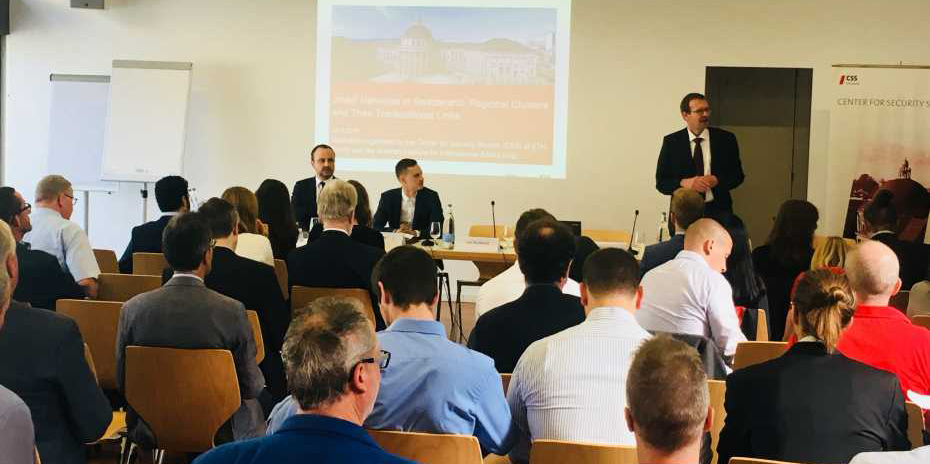On 25 May 2018, the Center for Security Studies at ETH Zurich, together with the Austrian Institute for International Affairs (oiip) and the University of Lucerne, hosted a conference on “Jihadi Networks in Switzerland: Regional Clusters and Transnational Links”. Experts from academia and politics discussed the similarities, differences and connections of jihadist networks in Switzerland, Austria, Germany, France, Belgium, Italy and the Balkans.
Four years after the proclamation of the caliphate in Syria and Iraq, the “Islamic state” (IS) is largely defeated militarily. The pace of its terrorist operations as well as its media activities have decreased significantly. Experts’ fears that IS would retreat into a “virtual caliphate” have not yet materialized.
Yet, even though the jihadist dream of an extremist utopia seems to have burst for the time being and IS has lost some of its appeal, radicalized individuals and small groups still pose a considerable threat. Accordingly, Switzerland’s third TETRA report (2017) assumes that attacks carried out by individuals or small groups with minimal logistical effort represent the greatest challenge for Switzerland.
Along similar lines, Switzerland’s Federal Intelligence Service (FSI) notes in its current report (2018) that in addition to the consumption of jihadist content on the Internet, personal networks and contacts play a central role when it comes to radicalization. These contacts are increasingly formed outside the confines of institutions such as mosques. Further, the core of these cross-border networks is often comprised of a few charismatic, radicalized individuals who aim to recruit others from within their own social circles.
The topic of jihadist extremism has occupied CSS researchers for quite some time. As early as 2013, the CSS published a comprehensive study on “Jihadist Radicalization in Switzerland.” Further analyses on jihadist foreign fighters and Swiss security (CSS Analysis No. 199, Bulletin 2014), the difficulties of dealing with jihadist returnees (CSS Analysis No. 210) and the engagement of Muslim organizations in Switzerland against violent extremism (Bulletin 2017) followed. Adding to this body of knowledge, the aim of the May 2018 conference was to take stock of the current research on jihadist networks in Switzerland and their transnational links.
Insights from the Conference
Radicals with North-African and Middle-Eastern backgrounds have long dominated domestic networks in Switzerland. However, jihadis with Balkan backgrounds – especially Bosnia-Herzegovina and Kosovo – currently represent more than one-third of all jihadi foreign fighters from Switzerland. The influence of radical preachers from the Balkans is also on the increase.
The emergence of local clusters, which are often characterized by pre-existing social ties, facilitates jihadi networking in Switzerland. The disproportionally high number of foreign fighters from cities like Winterthur or Lausanne indicates the existence of several such jihadi recruitment grounds within the country. While these clusters serve as epicenters for networks within the French, German and Italian-speaking regions in Switzerland, they do not maintain close national ties.
However, this does not mean these clusters constitute isolated islands within the center of Europe. Switzerland’s regional jihadi clusters are often linked to broader transnational networks in neighboring countries such as Germany, Austria, France, Belgium, and Italy. Furthermore, diasporic ties to radical communities in the homeland – as observed in the cases of Bosnia- Herzegovina or Kosovo – present ample evidence for the internationalization of the “Swiss Jihad.”
In order to take this internationalization of the Swiss jihadist problem into account, the conference brought together experts from Switzerland, Austria, Germany, France, Belgium, Italy and Bosnia-Herzegovina. Over the course of four panel discussions, participants looked at the various linguistic-ethnic networks and their respective international contacts. While the causes and motives for radicalization and violence continue to be heterogeneous and complex, there was a general consensus among most participants that personal networks and their transnational connections pose a threat that should not be underestimated.
With its recently adopted Counter Terrorism Strategy (2015), Switzerland is now relatively well prepared to combat jihadist-motivated terrorism. Nonetheless, the conference indicated that certain domestic networks continue to pose a significant threat. In order to better understand better how these networks operate, closer cooperation between national authorities in Europe is essential.
What the Future Holds
Unlike other countries, Switzerland does not appear to be a focal point for jihadist terrorism. Yet, no one knows which organizations and networks will emerge from the ties and contacts jihadists have formed in Syria and Iraq. The 11 September 2001 terrorist attacks have already shown that decades may pass between the initial formation of networks during a conflict and an actual attack. As a result, the threat posed by jihadist networks and returnees will almost certainly remain at the top of Switzerland’s security agenda.
Further CSS publications on the topic:
- Bulletin on Swiss Security Policy (2017), «Das Engagement Muslimischer Organisationen in der Schweiz gegen gewaltbereiten Extremismus»
- CSS analysis No. 210 (2017), «Dealing with Jihadist Returnees: A Tough Challenge»
- CSS analysis No. 199 (2016), «Switzerland and Jihadist Foreign Fighters»
- Bulletin on Swiss Security Policy (2014), «Foreign Fighters: Tickende Zeitbomben im Radar westlicher Entscheidungsträger»
- CSS Studie (2013), «Jihadist Radicalization in Switzerland»
This text is also available in German.
For more information on issues and events that shape our world, please visit the CSS website.



One reply on “Jihadi Networks in Switzerland: Regional Clusters and their Transnational Links”
The Swiss Government is just making the right decision. This is like an ounce of prevention for terrorist’s attack. Better coming out prepared than doing nothing at all.